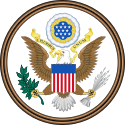Dan Quayle
| ||
 Wiceprezydent Dan Quayle w 1989 roku | ||
| Pełne imię i nazwisko | James Danforth Quayle III | |
| Data i miejsce urodzenia | 4 lutego 1947 Indianapolis | |
| 44. wiceprezydent Stanów Zjednoczonych | ||
| Okres działalności | od 20 stycznia 1989 do 20 stycznia 1993 | |
| Przynależność polityczna | Partia Republikańska | |
| Druga dama | Marilyn Quayle | |
| Poprzednik | George H.W. Bush | |
| Następca | Al Gore | |
 | ||
Dan Quayle, właśc. James Danforth Quayle (ur. 4 lutego 1947 w Indianapolis) – amerykański polityk, wiceprezydent Stanów Zjednoczonych w latach 1989–1993.
W 1969 r. ukończył DePauw University i w latach 1969–1975 służył w Gwardii Narodowej stanu Indiana. W 1974 ukończył prawo w Indiana University i został wydawcą i dyrektorem zarządzającym w Huntington Herald-Press. W 1976 został wybrany do Izby Reprezentantów Kongresu amerykańskiego, z ramienia republikanów. W 1980 został wybrany do Senatu Stanów Zjednoczonych, uzyskując ponownie mandat w 1986 r.
W 1988 kandydat na prezydenta George H.W. Bush zaproponował mu wspólny start w wyborach prezydenckich. Początkowo nie traktowany poważnie przez media, Quayle okazał się skutecznym prezesem prezydenckiej rady ds. konkurencyjności w biznesie, której zadaniem była deregulacja amerykańskiej gospodarki w duchu liberalizmu.
Podczas kampanii prezydenckiej w 1988 r. demokrata Lloyd Bentsen wypowiedział pod jego adresem słynne zdanie: Panie senatorze, żaden z pana Jack Kennedy. W 1991 Quayle został uhonorowany nagrodą Ig Nobla w dziedzinie edukacji, za demonstrowanie, lepiej niż ktokolwiek inny, potrzeby edukacji naukowej. Poprawił on podczas wizyty w szkole poprawnie napisane na tablicy słowo „potato” (ziemniak) na potatoe.
Ponownie nominowany na stanowisko wiceprezydenta w 1992, jednak w wyborach para Bush-Quayle przegrała z Demokratami Billem Clintonem i Alem Gore’em.
Bez skutku ubiegał się o nominację Partii Republikańskiej na prezydenta w 2000 roku.
Linki zewnętrzne
- Biografia w Biographical Directory of the United States Congress (ang.)
- Biografia Senat Stanów Zjednoczonych (ang.)
| ||||||||||||||
| |||||||||
| ||||||||
Media użyte na tej stronie
Seal of the Vice President of the United States. The blazon is defined in Executive Order 11884 as:
The design is the same as the Seal of the President of the United States, except that there is no ring of stars, the clouds are gray (instead of proper), the stars are gray (instead of argent), the scroll is gray (instead of white), the arrows are gray (instead of proper), and the background colors and inscription (obviously) differ.The Coat of Arms of the Vice President of the United States shall be of the following design:
SHIELD: Paleways of thirteen pieces argent and gules, a chief azure; upon the breast of an American eagle displayed holding in his dexter talon an olive branch proper and in his sinister a bundle of thirteen arrows gray, and in his beak a gray scroll inscribed "E PLURIBUS UNUM" sable.
CREST: Behind and above the eagle a radiating glory or, on which appears an arc of thirteen cloud puffs gray, and a constellation of thirteen mullets gray.
The Seal of the Vice President of the United States shall consist of the Coat of Arms encircled by the words "Vice President of the United States."
Logo of the United States White House, especially in conjunction with offices like the Chief of Staff and Press Secretary.
Department of Defense portrait of Vice President Dan Quayle
Official portrait of President George H. W. Bush
Logo of the Connecticut Republican Party
Signature of Dan Quayle.












